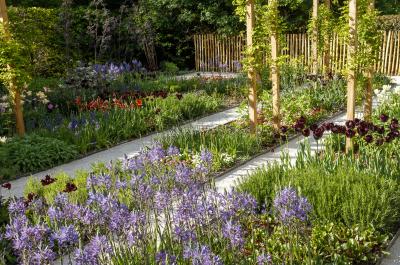04bis. Le Jardin Patchwork
The patchwork garden
Awarded on the 21st of June 2023 by a jury of professionals renowned in the world of garden art

This edible garden is the result of a need for food self-sufficiency. Over the course of the centuries, gardens have evolved as regards form and function alike. These days, they are subjected to the pressures of climate change, which makes it hard for plants to survive. In parallel, threats of war and aggression are destabilising our world. Resilience has become a necessity in all areas, and the garden can be the best example in this regard. In this particular case, its purpose is to go back to essentials, creating a pleasant spot with all the benefits provided by the beautiful edible plants and shrubs that grow in it: a patchwork of bulbs, annuals and perennials that flower at different seasons, surrounded by ground-cover shrubs and plants. Pergolas covered with climbing plants provide shade alongside daylily flowers, Camassia bulbs and Jerusalem artichoke tubers.
The garden is also a biodiversity reservoir, a paradise for bees, butterflies and other insects. The plants it contains have been deliberately selected from across the world, as climate change enables other types of plants to be grown. An expression of interest in other cultures, Le Jardin Patchwork (The Patchwork garden) is an area that offers us comfort, capable of nourishing bodies and minds alike, an experiment in solidarity.
DESIGNERS

Annelies Dijkman is a visual artist, garden designer and gardener from the Netherlands. She is specialized in creating site-specific artworks. Her artworks are mainly made for public space, like a cemetery, a residential area or a school. Trees and plants are often part of her works and sometimes a garden itself is the artwork. She is particularly inspired by the meaning that nature, landscape, trees and plants hold for people and their environment. For one person an apple tree is mainly an object of use because of the fruit that it produces, while another sees the tree's blossom in spring and the beauty of its form. This cultural layer is reflected in the artworks she produces. The garden as a cultural space has always had her special interest and she has realized several gardens over the years. To learn more about the art of gardening and plants, she finished a training in gardening. She works regularly in a schoolgarden with children that have behavioural problems. Due to this experience, she sees the garden not only as a cultural and artistic space, but also as a place for mental and physical health.
Lau Heemskerk is a gardener, garden designer and grower of perennials from the Netherlands. She was born in Hong Kong and raised in the Netherlands and Germany. After graduating at the horticultural school, she went on to study dendrology to become a better grower. In the area where she lives, near Amsterdam, several of her designs to improve public green space have been realised. Other realised designs are for private gardens. She participates in nature and environmental education for children and is active in nature-related community work. Her interest in growing and gardening arose after spending time in beautiful rural Vinkeveen in her youth, following a move from busy concrete Hong Kong to the old centre of Amsterdam. This made her a passionate gardener who experiments with compositions in edible plants while always respecting the environment and sustainability.


